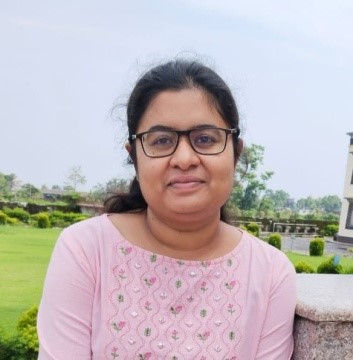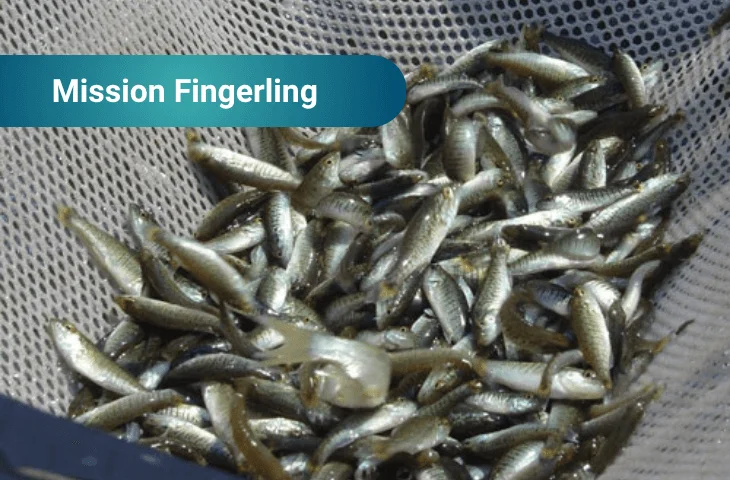India’s fisheries and aquaculture sector is often called the “sunshine sector” of Indian agriculture. It has a huge potential to generate employment, boost exports, and ensure nutritional security. With India being the second-largest fish producer in the world, the government has prioritized fisheries as a critical area for agricultural diversification.
In this context, the Blue Revolution, an umbrella program for fisheries development, was launched to achieve integrated and holistic growth in the sector. A key part of this revolution is Mission Fingerling, launched in March 2017 by the Union Ministry of Agriculture and Farmers’ Welfare.
What is Mission Fingerling?
Mission Fingerling is a central government initiative under the Blue Revolution scheme, designed to enhance fish production and productivity. Its main focus is on producing and supplying large quantities of high-quality fingerlings (young fish) for stocking in ponds, reservoirs, and other water bodies.
The scheme aims not just at increasing fish output but also at strengthening infrastructure, supporting farmers, and ensuring the sustainability of fisheries resources.
Why was Mission Fingerling Launched?
The fisheries sector in India is vital but has long suffered from issues such as:
- Low productivity per fisher/boat/farm compared to global standards.
- Over-exploitation of nearshore marine resources, while deep-sea resources remain untapped.
- Poor seed quality and inadequate hatchery infrastructure.
- High demand for animal protein and fish exports, which requires increased production.
With fisheries contributing significantly to foreign exchange earnings (Rs. 47,000+ crore exports in 2019) and being the largest agricultural export, the government identified that the first step toward sustainable growth lies in quality seed production and distribution.
Check Out: Complete List of Important Schemes for NABARD Grade A Exam
What are the Key Objectives of Mission Fingerling?
Mission Fingerling has a clear set of objectives that align with the goals of the Blue Revolution:
1. Increase Fingerling Production – Large-scale production of fish fingerlings, shrimp post-larvae, and crab seed to meet the demand of expanding aquaculture and fish farming activities.
2. Improve Fingerling Quality – Ensuring supply of healthy, disease-free, and fast-growing seed to enhance survival rates and improve growth performance in grow-out ponds.
3. Strengthen Infrastructure – Setting up new hatcheries and fingerling rearing ponds, along with upgrading existing hatchery infrastructure to meet modern standards.
4. Boost Fisheries Output – Enhancing fish production significantly to achieve Blue Revolution targets (150 lakh tonnes by 2019-20) and supporting India’s ambition to be a hub of sustainable fish production.
5. Benefit Farmers and Fishers – Providing access to better quality seed and higher productivity, thereby enhancing income levels of fish farmers and ensuring socio-economic development of fishing communities.
Get ready to crack government job exams with leading educators
How does Mission Fingerling Work?
Mission Fingerling adopts a strategic and practical approach for implementation.
| Subtopic | Details |
| Targeted Stocking | Advanced fingerlings are stocked in ponds, reservoirs, and tanks. These fingerlings grow faster, ensuring higher yields and shorter production cycles. |
| Infrastructure Development | Establishment of hatcheries and nurseries across 20 identified states. States with higher potential are prioritized for infrastructure investment. |
| Strategic State-Level Planning | States are selected based on fishery potential, water resources, and existing infrastructure. Localized seed distribution plans are created to reach remote fishing communities. |
| Capacity Building | Training of fish farmers and hatchery operators in best practices. Awareness about disease management, feed quality, and improved stocking methods. |
How does Mission Fingerling Link with the Blue Revolution?
The Blue Revolution was launched to achieve integrated development of fisheries and aquaculture in India. Mission Fingerling is one of its flagship programs, directly contributing to its goals. The Blue Revolution’s targets include:
- Increasing fish production from 107.95 lakh tonnes (2015-16) to 150 lakh tonnes (2019-20).
- Enhancing export earnings through marine and inland fisheries.
- Supporting fishers’ welfare, infrastructure, and sustainability.
Mission Fingerling contributes by ensuring that quality fish seed, the most critical input for aquaculture, is adequately available. Without seed production, targets for the Blue Revolution would be unattainable.
What are the Issues and Challenges in the Fisheries Sector?
Mission Fingerling operates within the broader fisheries sector, which faces multiple challenges:
- Overfishing and Resource Depletion
- Around 90% of marine fish stocks are fully exploited or overfished (FAO reports).
- Nearshore waters are overcrowded, while deep-sea potential remains underutilized.
- Low Productivity
- India’s productivity per fisher is 4-5 kg/day, compared to 250 kg/day in Norway.
- Infrastructure Gaps
- Lack of cold chain facilities, modern harbors, feed mills, and diagnostic centers.
- Technological Limitations
- Dependence on traditional methods with limited mechanization.
- Socio-economic Constraints
- Most fishers are economically backward, with limited access to finance, insurance, and modern technology.
Also Check: List of Government Schemes of India
How can Mission Fingerling Help Overcome these Issues?
Mission Fingerling directly addresses key problems by:
- Providing quality fish seed improves productivity and survival rates.
- Establishing hatcheries and nurseries closes the infrastructure gap.
- Encouraging diversification (shrimp, crab, freshwater species).
- Training fishers and farmers bridges knowledge and technology gaps.
- Boosting income supports government’s aim of doubling farmers’ income.
What is the Way Forward for Mission Fingerling and Fisheries in India?
For long-term sustainability, India needs:
- Expansion of aquaculture through cage culture, recirculatory systems, and reservoir stocking.
- Increased investment in fishery infrastructure (ice plants, processing units, storage).
- Scientific management of marine resources to prevent overfishing.
- Comprehensive fisheries education and research.
- Balanced approach avoiding large-scale industrial fishing that harms small fishers’ livelihoods.
Key Takeaways
| Aspect | Details |
| Launched | March 2017, Ministry of Agriculture & Farmers’ Welfare |
| Part of | Blue Revolution Program |
| Focus | Production of high-quality fish fingerlings |
| Key Objectives | Increase production, improve quality, strengthen infrastructure, benefit farmers |
| Implementation | Hatcheries, nurseries, targeted stocking in 20 identified states |
| Link to Blue Revolution | Supports fish production target (150 lakh tonnes by 2019-20) |
| Significance | Enhances fish output, boosts exports, supports fishers’ livelihood |
| Challenges Addressed | Low productivity, poor seed quality, infrastructure gaps, socio-economic issues |
Also Read:
Questions based on Mission Fingerling
1. Mission Fingerling was launched in which year?
a) 2014
b) 2015
c) 2016
d) 2017
e) 2018
Answer: d) 2017
2. Mission Fingerling is part of which larger program?
a) Green Revolution
b) White Revolution
c) Blue Revolution
d) Digital India
e) Operation Flood
Answer: c) Blue Revolution
3. The primary focus of Mission Fingerling is:
a) Enhancing irrigation facilities
b) Improving seed quality and production of fingerlings
c) Promoting deep-sea fishing only
d) Expanding export subsidies
e) Controlling fish prices
Answer: b) Improving seed quality and production of fingerlings
4. Which ministry launched Mission Fingerling?
a) Ministry of Fisheries and Animal Husbandry
b) Ministry of Agriculture and Farmers’ Welfare
c) Ministry of Food Processing Industries
d) Ministry of Rural Development
e) Ministry of Environment
Answer: b) Ministry of Agriculture and Farmers’ Welfare
5. How many states were identified for strengthening fish seed infrastructure?
a) 10
b) 12
c) 15
d) 20
e) 25
Answer: d) 20
6. Which country has higher fisher productivity than India?
a) China
b) Norway
c) USA
d) Brazil
e) Japan
Answer: b) Norway
7. What is the fish productivity per fisher in India?
a) 2-3 kg/day
b) 4-5 kg/day
c) 20-25 kg/day
d) 100 kg/day
e) 250 kg/day
Answer: b) 4-5 kg/day
8. India’s fisheries exports in 2019 were worth approximately:
a) Rs. 20,000 crore
b) Rs. 30,000 crore
c) Rs. 47,000 crore
d) Rs. 60,000 crore
e) Rs. 1,00,000 crore
Answer: c) Rs. 47,000 crore
9. Which species are included in Mission Fingerling seed production?
a) Fish only
b) Fish and shrimp
c) Fish, shrimp, and crab
d) Only crab
e) Only shrimp
Answer: c) Fish, shrimp, and crab
10. The target fish production under Blue Revolution (by 2019-20) was:
a) 100 lakh tonnes
b) 107.95 lakh tonnes
c) 150 lakh tonnes
d) 200 lakh tonnes
e) 250 lakh tonnes
Answer: c) 150 lakh tonnes
- MISHTI Scheme, India’s Initiative to Restore Mangrove Ecosystems
- National Green Hydrogen Mission Features, Objectives, and Benefits
- Paramparagat Krishi Vikas Yojana, Transforming India’s Organic Farming
- Mission on Integrated Development of Horticulture NHM and HMNEH
- Swachh Bharat Mission, India’s Journey Towards Cleanliness and Hygiene
- SAGY, A Step Towards Holistic Development of Indian Villages

Hi, I’m Aditi. I work as a Content Writer at Oliveboard, where I have been simplifying exam-related content for the past 4 years. I create clear and easy-to-understand guides for JAIIB, CAIIB, and UGC exams. My work includes breaking down notifications, admit cards, and exam updates, as well as preparing study plans and subject-wise strategies.
My goal is to support working professionals in managing their exam preparation alongside a full-time job and to help them achieve career growth.
